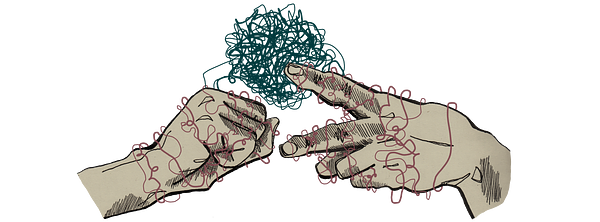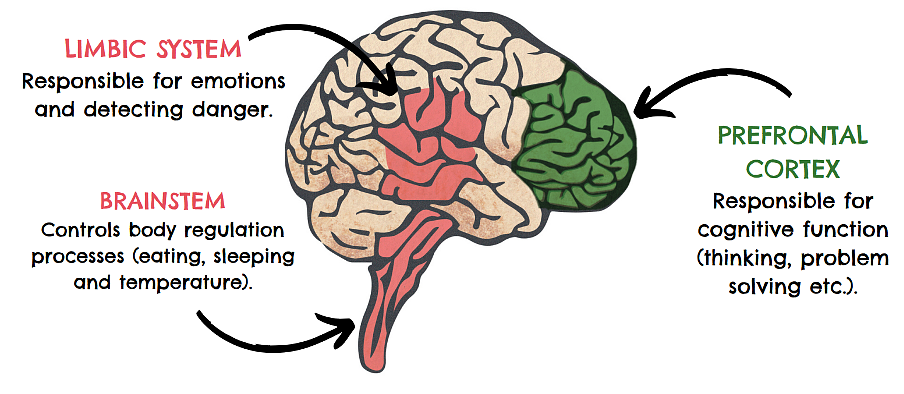Professionals and Practitioners
This digital resource tells the story of how our brains interpret the world around us and how this translates in our bodies, emotions and behaviours. It has been designed to be used by professionals working with young people interested in learning more about the science of conflict and boosting their wellbeing.

Reactive and Reflective Responses
Summary
- The brain is the most complex organ in the body. Three parts of the brain are in particular involved in conflict: the Brainstem, the Limbic System and Prefrontal Cortex.
- We call the brain’s oldest part our “Lizard” or “Reptilian” brain, which consists of the Brainstem and the Limbic System.
- The Lizard Brain was developed first to protect us from predators and other threats.
- The Prefrontal Cortex is, in evolutionary terms, a younger part of our brain. It comprises what we call our ‘Monkey’ or ‘Mammalian’ brain.
- Our Monkey brain developed after the Lizard brain to help our species work in groups and therefore achieve more than we could as individual organisms.
- We can say that the Lizard part of our brain is involved with reactive responses to conflict, while the Monkey brain is involved in reflective responses.
- Sometimes when we are overwhelmed with emotion, our Lizard and Monkey brains lose connection and the Lizard brain takes over. At this point, our bodies begin to prepare for “fight or flight”.
- Our brain development can also affect the Monkey/Lizard brain connection. Brain development can be affected by age and life experience
Monkey and Lizard Brains
The information in this section is taken from SCCR’s psychoeducational resource Monkey Vs Lizard, which can be found here on SCCR’s website.
The brain is the most complex organ in the body and controls our thoughts, memory, emotion, behaviours and all the processes that regulate our body.
As far as understanding behaviours that manifest during conflict, there are three parts of the brain we need to know about: the Brainstem, the Limbic System and Prefrontal Cortex.
The illustration below depicts the three parts and what they are responsible for.

When we talk about reactive and reflective responses to conflict, we’re talking about more than just the immediate cause of an argument. We’re looking way back into the dawn of humanity.
Our brain is a record of man’s evolutionary past. We call the brain’s oldest part our “Lizard” or “Reptilian” brain, which consists of the Brainstem and the Limbic System. We call it our Lizard brain as the Limbic System is about all a lizard has for brain function.
The Lizard Brain was developed first to protect us from predators and other threats. It is essential for survival.
The Prefrontal Cortex is, in evolutionary terms, a younger part of our brain. It comprises what we call our ‘Monkey’ or ‘Mammalian’ brain. Our Monkey brain developed after the Lizard brain to help our species work in groups and therefore achieve more than we could as individual organisms.
The Monkey brain helps us in several ways. It provides us with focus and helps us set goals. Through it, we’re able to predict events and plan; our prefrontal cortex promotes empathy, which helps us understand what others are thinking; and it’s involved in impulse control and managing emotions.
We can say that the Lizard part of our brain is involved with reactive responses to conflict, while the Monkey brain is involved in reflective responses.
Sometimes when we are overwhelmed with emotion, our Lizard and Monkey brains lose connection and the Lizard brain takes over. At this point, our bodies begin to prepare for “fight or flight”.
Fight or Flight
Most of the time our Monkey and Lizard Brains work together. Our Lizard brain detects emotions and possible danger, and the Monkey Brain evaluates and reflects on the information, considers different viewpoints and uses problem solving to resolve conflicts.
Sometimes when we are overwhelmed with emotion, our Lizard and Monkey brains lose connection and the Lizard brain takes over.
At this point, our bodies begin to prepare for “fight or flight”. Verywellmind.com describes the flight or fight response in this way:
The term "fight-or-flight" represents the choices our ancient ancestors had when faced with danger in their environment: to either fight or flee. In either case, the physiological and psychological response to stress prepares the body to react to the danger.
When we feel threatened, a sudden release of neurochemicals, including adrenaline and cortisol, activates our nervous system (if you want to learn more about neurochemicals and their role in managing mood, read ‘Brain Chemicals and Emotional states’). Our bodies are now preparing to run away or to fight; in some cases, we freeze. These responses comprise our survival mode.
Signs that our fight or flight response has been triggered include: an increased heart rate; breathing harder; dilated pupils; shaking.
Verwellmind.com continues:
Your body can stay in fight-or-flight for 20 to 60 minutes after the threat is gone, which is how long it takes for the parasympathetic nervous system to return it to pre-arousal levels. The sympathetic nervous system promotes the fight-or-flight response while the parasympathetic nervous system helps calm the body once the threat is gone.
Brain Development
One shouldn’t think that because the Lizard part of our brain is involved with “fight or flight” while the Monkey part is concerned with empathy and problem-solving, that one part of the brain is “good” or better than the other. The Lizard part of our brain has survived through evolution because it serves a purpose still. Its origins may lie in helping early humans to escape predators that are no longer a concern, but there will be times in all our lives when it will be better to run away or defend ourselves.
The problem comes when, in combination with other factors, we find it difficult to control our ‘fight or flight’ response, so that we find ourselves without the knowledge or experience to pull back from conflicts that threaten to damage relationships.
There are many factors that affect our response to conflict such as who we are in conflict with, where and when the conflict takes place, and how we are feeling at the time.
Our brain development can also affect the Monkey/Lizard brain connection which determines how we respond to conflict.
References and Further Reading
- What Is the Fight-or-Flight Response? by Kendra Cherry. Very Well Mind, 2022.
- Your Lizard Brain by Davia Sills. Psychology Today, 2014.
- Triune Brain. Wikipedia, 2024.
- Prefrontal Cortex. Good Therapy, 2023.





